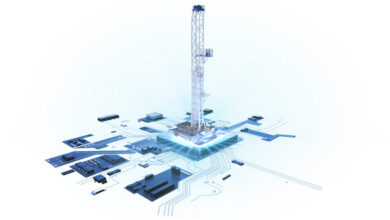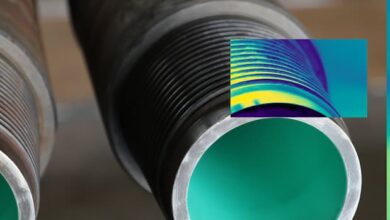D&C Tech Digest
Subsea Services Alliance to engineer 15,000-psi intervention riser system

Subsea Services Alliance, the collaboration among Helix Energy Solutions Group, OneSubsea and Schlumberger, has announced the first joint technology project between OneSubsea and Helix to engineer and manufacture a 15,000-psi intervention riser system. This technology advances the alliance’s objectives to offer well intervention solutions to service the increasing number of high-pressure wells in the subsea environment. The system, which will be available on a rental basis in mid-2017, is being engineered and built at OneSubsea facilities in Leeds, UK.
Helix President and CEO Owen Kratz said, “This new jointly owned system will allow us to service a wider range of our client’s well stock. It shows that even in a downturn we are able to target new and exciting opportunities.”
OneSubsea CEO Mike Garding stated: “By combining the operational expertise of Helix Energy Solutions with OneSubsea’s world-class engineering and manufacturing capability, we are creating well access and control packages that will expand today’s operating envelope to deeper and higher-temperature environments. The announcement for the 15,000-psi intervention riser system is one of the first steps we are taking on the road to become the pioneers in subsea well intervention.”
DNV issues technical guide, new recommended practice
DNV GL has issued an Offshore Technical Guide providing guidance on how dynamic-positioning systems based on closed bus-ties configuration can be designed and verified with additional protection and monitoring facilities to ensure integrity and robustness. The guidance addresses the critical issue of testing by recommending test requirements that safeguard equipment from damage during testing, while at the same time obtaining sufficient evidence of robustness. The guidance addresses the critical issue of testing by recommending test requirements that safeguard equipment from damage during testing, while at the same time obtaining sufficient evidence of robustness.
Separately, DNV has also released a new Recommended Practice (RP), “Steel Forgings for Subsea Applications.” Steel forgings are important building blocks for subsea components and are often tailored to meet end-users’ specific requirements. This results in long delivery times and repeated follow-ups throughout the supply chain.
DNV’s new RP harmonizes these requirements aims to enable reduced lead times, enhanced stock keeping, interchangeability of forgings and help to improve and maintain consistent quality.
87-stage well completed in 85 hours for Devon in Powder River Basin
NCS Multistage recently completed an 87-stage well in 85 hours for Devon Energy – less than one hour per frac stage, NCS announced. All fracs were single-point injection using NCS’ coiled-tubing frac system.
During one stretch, 40 fracs were performed in a record time of 24 hours, an average of 36 minutes per stage. The well is located in the Powder River Basin, Wyo. The NCS Multistage casing sleeves were run and cemented as part of the production casing string. During completion, the frac-isolation tool was run on coiled tubing to locate and open each sleeve. The completion was performed in a single coiled-tubing run. “The Multistage Unlimited system performed beautifully in this extended lateral,” Joe DeGeare, NCS Multistage VP of US Sales and Operations, said. “Right now, operators want to control costs, and executing completions this quickly certainly helps. In addition, when we pulled our tool after the last frac, the well was full drift from top to bottom ready to produce.”
APS Technology’s rotary steerable system tested with doglegs up to 6.5°/100 ft
 APS Technology announced the successful first drilling test of its SureSteer 475-rss rotary steerable system. The tool was used to drill a directional borehole at the company’s Wallingford, Conn., drilling test facility. Successful and consistent performance was observed while building and turning the well, with doglegs up to 6.5˚/100 ft. Using proprietary control systems, the tool can be programmed to use an automated closed-loop feedback system for vertical or tangent angle control or to operate with surface-supplied instructions. For steering, the desired tool face is set by surface orientation, similar to a steerable motor.
APS Technology announced the successful first drilling test of its SureSteer 475-rss rotary steerable system. The tool was used to drill a directional borehole at the company’s Wallingford, Conn., drilling test facility. Successful and consistent performance was observed while building and turning the well, with doglegs up to 6.5˚/100 ft. Using proprietary control systems, the tool can be programmed to use an automated closed-loop feedback system for vertical or tangent angle control or to operate with surface-supplied instructions. For steering, the desired tool face is set by surface orientation, similar to a steerable motor.
Liner installation time for extended-reach wells in Venezuela reduced by 85%
Petroindependencia, a joint venture of Venezuelan national oil company PDVSA, has used an uncemented liner hanger system in 25 heavy oil wells to save $590,000.
Extended-reach wells drilled through unconsolidated sandstone with shale laminations in the Cerro Negro oil field in Venezuela presented significant completion challenges for Petroindependencia. The average length of the 8.61-in. diameter, open-hole horizontal sections was 4,500 ft, and the maximum dogleg severity was 7°/100 ft. Successful liner deployment in these long, uncemented laterals required the ability to rotate, push and pull the liner.
In addition, production of the heavy oil (9°API) would require steam injection during later stages of development. Consequently, all completion hardware had to be rated for the extreme conditions that were anticipated. Service quality incidents during completion of the first well had resulted in a fishing operation, which, combined with various technical limitations, led to a liner installation time of 10 days. With 13 more wells to complete by year-end, the operator was on a tight schedule with little margin for error.
Schlumberger’s COLOSSUS UNC uncemented liner hanger system was selected for this project. The system helps to facilitate successful liner deployment in uncemented vertical and long-reach horizontal wellbores, and it can be easily configured for high-temperature environments. The system’s push, pull and rotation capabilities enable the liner to reach target depth quickly even in extended-reach wells. At the same time, the hydraulic setting capability avoids excessive workstring manipulation, which can be damaging in highly deviated wells. While running in hole, a large bypass area reduces the piston effect, thereby enabling higher speeds. The liner hanger and packer are on the same mandrel and are set simultaneously, maximizing system integrity and simplifying operations. Thermal elastomers suitable for steam-injection applications were used for the packer element.
Faster liner deployment
The 600°F-rated COLOSSUS UNC uncemented liner hanger system was supplemented with Schlumberger Completions Domain Support, which included torque-and-drag analysis and well preparation recommendations. Wells were placed on production earlier than previously possible, helping the operator achieve its production goals for the year.
The operator has continued to use this liner hanger system; a total of 25 wells have been completed to date with an average liner deployment time of 30 hours/well and zero NPT, saving Petroindependencia an estimated $590,000, according to Schlumberger.
Ziebel conducts distributed fiber optic sensing on Statoil’s Huldra platform
 Ziebel, a Stavanger-based provider of specialist well intervention services for the oil and gas industry, has completed a distributed fiber optic sensing campaign for Statoil. The Z-Line, a gravity-deployed carbon composite cable, was used to gather distributed temperature and distributed acoustic fiber optic data on the Huldra installation, Statoil’s first unmanned platform, which ceased production in September 2014. The interventions were carried out to optimize Statoil’s plans to plug and abandon the installation next year.
Ziebel, a Stavanger-based provider of specialist well intervention services for the oil and gas industry, has completed a distributed fiber optic sensing campaign for Statoil. The Z-Line, a gravity-deployed carbon composite cable, was used to gather distributed temperature and distributed acoustic fiber optic data on the Huldra installation, Statoil’s first unmanned platform, which ceased production in September 2014. The interventions were carried out to optimize Statoil’s plans to plug and abandon the installation next year.
From the Huldra platform, the Z-Line was run in two wellbores to measure temperature and acoustic profiles. Work was carried out over two separate three-day periods in April and May 2015. Each operation was completed as planned, providing data that displays the conditions of each well in its entirety during each intervention. It allows Statoil to observe fluid movements, confirm the integrity of the wells and plan the final abandonment.
The Z-Line is a 3/16-in. (4.8-mm) diameter carbon composite line with embedded optical fibers at its core. This enables distributed temperature sensing and distributed acoustic sensing to be performed along the full length of the line. In addition, optical point pressure and temperature sensors are contained within the bottomhole assembly (BHA), along with a connection to enable standard memory logging tools to be run below the BHA. The rig-up and footprint are similar to that of a standard wireline cased-hole setup, although the distributed measurement acquisition method does differ in that it is carried out with the line parked stationary in the well.
The carbon composite material enables the line to have an extremely high strength-to-weight ratio, with a breaking strength (6,600 lb/3,000 kg) well in excess of what can be achieved with a similar diameter of steel wire or braided line. The smooth outer finish makes for effective sealing, and the low friction coefficient to steel plus the relative stiffness of the line gives it increased ability to reach into deviated wells. In addition, the low friction reduces the abrasion and tubing wear associated with standard wireline or slickline runs.
Click here to visit DC’s Innovating While Drilling microsite, where you can find more articles about industry technology milestones and downhole or subsea innovations.




